A) A.
B) B + C.
C) A + B + D.
D) C.
F) A) and B)
Correct Answer

verified
Correct Answer
verified
Multiple Choice
Countries that restrict foreign trade are likely to
A) forgo the additional surplus that trade allows,but will probably enjoy economies of scale.
B) forgo the additional surplus that trade allows,but will be compensated by a higher rate of technological change.
C) forgo the additional surplus that trade allows,but will have a lower rate of unemployment.
D) have more firms with domestic market power.
F) A) and C)
Correct Answer

verified
Correct Answer
verified
Multiple Choice
Figure 9-13 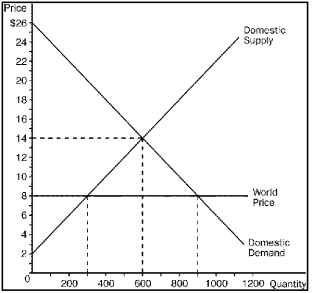 -Refer to Figure 9-13.Consumer surplus after trade is
-Refer to Figure 9-13.Consumer surplus after trade is
A) $3,600.
B) $5,400.
C) $7,200.
D) $8,100.
F) C) and D)
Correct Answer

verified
Correct Answer
verified
Multiple Choice
Figure 9-6 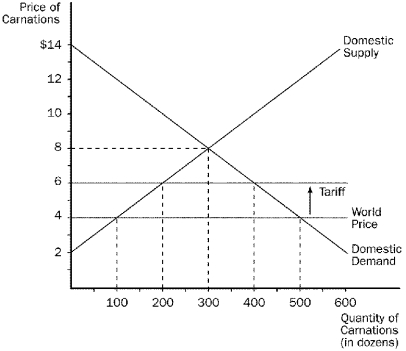 -Refer to Figure 9-6.Before the tariff is imposed,this country
-Refer to Figure 9-6.Before the tariff is imposed,this country
A) imports 200 carnations.
B) imports 400 carnations.
C) exports 200 carnations.
D) exports 400 carnations.
F) A) and C)
Correct Answer

verified
Correct Answer
verified
Multiple Choice
Figure 9-9 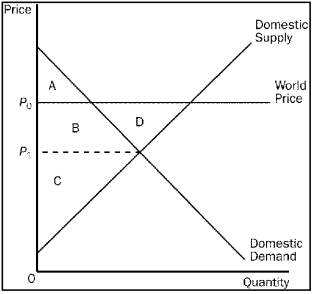 -Refer to Figure 9-9.Producer surplus in this market before trade is
-Refer to Figure 9-9.Producer surplus in this market before trade is
A) A.
B) A + B.
C) B + C + D.
D) C.
F) A) and C)
Correct Answer

verified
Correct Answer
verified
Multiple Choice
A quota is
A) a tax placed on imports.
B) a limit on the quantity of imports.
C) a tax on exports to other countries.
D) an excess of exports over imports.
F) A) and D)
Correct Answer

verified
Correct Answer
verified
Multiple Choice
Figure 9-6  -Refer to Figure 9-6.The imposition of a tariff on carnations
-Refer to Figure 9-6.The imposition of a tariff on carnations
A) increases the number of carnations imported by 100.
B) increases the number of carnations imported by 200.
C) decreases the number of carnations imported by 200.
D) decreases the number of carnations imported by 400.
F) A) and C)
Correct Answer

verified
Correct Answer
verified
Multiple Choice
Figure 9-1
The figure illustrates the market for wool in New Zealand. 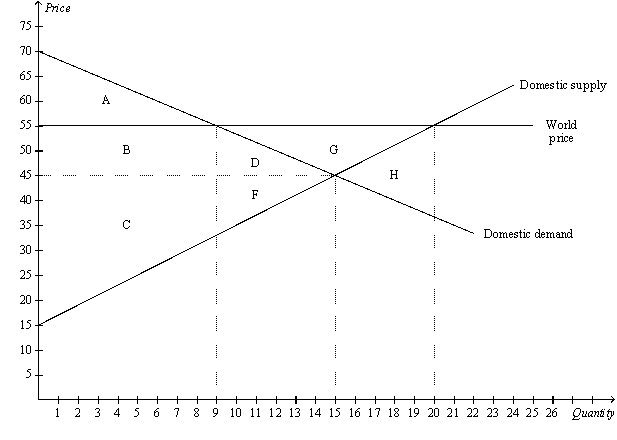 -Refer to Figure 9-1.With trade,New Zealand will
-Refer to Figure 9-1.With trade,New Zealand will
A) export 11 units of wool.
B) export 5 units of wool.
C) import 15 units of wool.
D) import 6 units of wool.
F) B) and C)
Correct Answer

verified
Correct Answer
verified
Multiple Choice
The principle of comparative advantage asserts that
A) not all countries can benefit from trade with other countries.
B) the world price of a good will prevail in all countries,regardless of whether those countries allow international trade in that good.
C) countries can become better off by exporting goods,but they cannot become better off by importing goods.
D) countries can become better off by specializing in what they do best.
F) None of the above
Correct Answer

verified
Correct Answer
verified
Multiple Choice
Figure 9-17 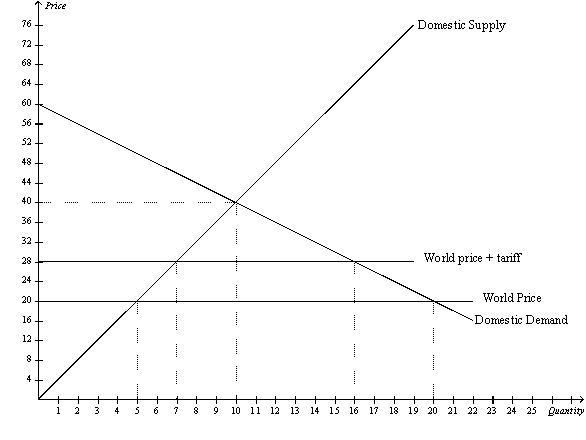 -Refer to Figure 9-17.With trade and a tariff,total surplus is
-Refer to Figure 9-17.With trade and a tariff,total surplus is
A) $306.
B) $354.
C) $378.
D) $426.
F) A) and C)
Correct Answer

verified
Correct Answer
verified
Multiple Choice
Figure 9-6  -Refer to Figure 9-6.When the tariff is imposed,domestic consumers
-Refer to Figure 9-6.When the tariff is imposed,domestic consumers
A) lose by $500.
B) lose by $900.
C) gain by $500.
D) gain by $900.
F) B) and C)
Correct Answer

verified
Correct Answer
verified
Multiple Choice
Figure 9-1
The figure illustrates the market for wool in New Zealand.  -Refer to Figure 9-1.From the figure it is apparent that
-Refer to Figure 9-1.From the figure it is apparent that
A) New Zealand will export wool if trade is allowed.
B) New Zealand will import wool if trade is allowed.
C) New Zealand has nothing to gain either by importing or exporting wool.
D) the world price will fall if New Zealand begins to allow its citizens to trade with other countries.
F) A) and C)
Correct Answer

verified
Correct Answer
verified
Multiple Choice
When a country allows international trade and becomes an exporter of a good,
A) domestic producers of the good become better off.
B) domestic consumers of the good become worse off.
C) the gains of the winners exceed the losses of the losers.
D) All of the above are correct.
F) A) and B)
Correct Answer

verified
Correct Answer
verified
Multiple Choice
Figure 9-10.The figure applies to the nation of Australia and the good is cameras. 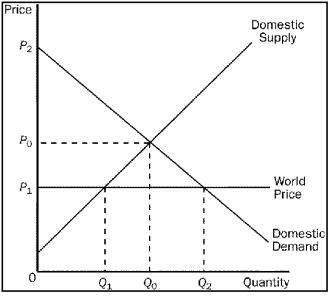 -Refer to Figure 9-10.Australia's gains from trade are represented by the area that is bounded by the points
-Refer to Figure 9-10.Australia's gains from trade are represented by the area that is bounded by the points
A) (0,P0) ,(Q0,P0) ,(Q2,P1) ,and (0,P1) .
B) (0,P1) ,(0,P2) ,(Q0,P0) ,and (Q1,P1) .
C) (Q0,P0) ,(Q2,P1) ,and (Q1,P1) .
D) (0,P0) ,(0,P2) ,and (Q0,P0) .
F) A) and D)
Correct Answer

verified
Correct Answer
verified
Multiple Choice
If the demand curve and the supply curve for a good are straight lines,then the deadweight loss that results from a tariff is represented on the supply-and-demand graph by
A) the area of one triangle.
B) the area of one rectangle.
C) the combined areas of two different triangles.
D) the combined areas of two different rectangles.
F) B) and D)
Correct Answer

verified
Correct Answer
verified
True/False
A multilateral approach to free trade has greater potential to increase the gains from trade than a unilateral approach,because the multilateral approach can reduce trade restrictions abroad as well as at home.
B) False
Correct Answer

verified
Correct Answer
verified
Multiple Choice
Figure 9-9  -Refer to Figure 9-9.Producer surplus in this market after trade is
-Refer to Figure 9-9.Producer surplus in this market after trade is
A) A.
B) A + B.
C) B + C + D.
D) C.
F) None of the above
Correct Answer

verified
Correct Answer
verified
Multiple Choice
Figure 9-5 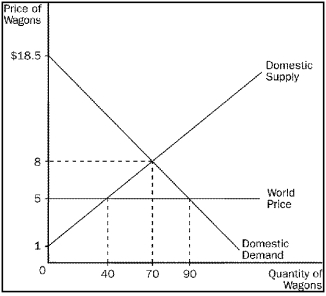 -Refer to Figure 9-5.With trade,producer surplus is
-Refer to Figure 9-5.With trade,producer surplus is
A) $80.
B) $150.
C) $210.
D) $245.
F) B) and D)
Correct Answer

verified
Correct Answer
verified
Multiple Choice
Critics of free trade sometimes argue that allowing imports from foreign countries causes a reduction in the number of domestic jobs.An economist would argue that
A) foreign competition may cause unemployment in import-competing industries,but the effect is temporary because other industries,especially exporting industries,will be expanding.
B) foreign competition may cause unemployment in import-competing industries,but the increase in consumer surplus due to free trade is more valuable than the lost jobs.
C) the critics are correct,so countries must protect their industries with tariffs or quotas.
D) foreign competition may cause unemployment in import-competing industries,but the increase in the variety of goods consumers can choose from is more valuable than the lost jobs.
F) A) and D)
Correct Answer

verified
Correct Answer
verified
Multiple Choice
A tariff is a tax placed on
A) an exported good and it lowers the domestic price of the good below the world price.
B) an exported good and it ensures that the domestic price of the good stays the same as the world price.
C) an imported good and it lowers the domestic price of the good below the world price.
D) an imported good and it raises the domestic price of the good above the world price.
F) A) and C)
Correct Answer

verified
Correct Answer
verified
Showing 181 - 200 of 333
Related Exams